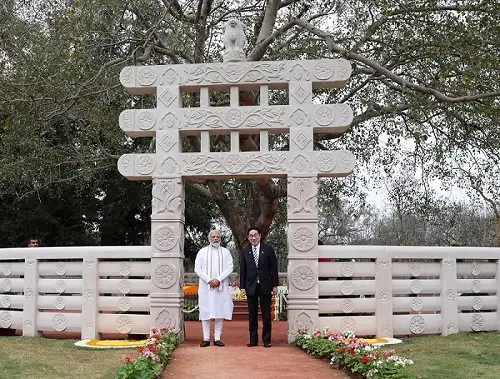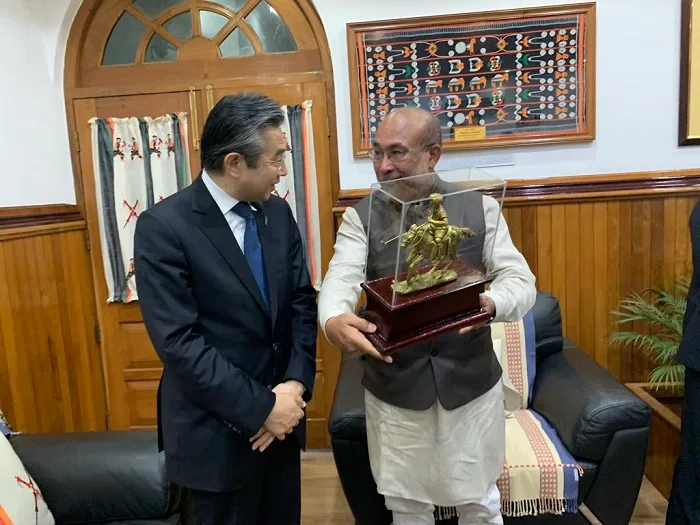India and Japan continue to work on a mechanism through which the young and promising youths of the northeast region can hone their skills and go on to work in all corners of the world.
Earlier this week, Japan’s Ambassador to India Hiroshi Suzuki called on Manipur Chief Minister Nongthombam Biren Singh in Imphal to hold what he later described as “fruitful discussions” on expanding Japan-Manipur cooperation and building on the foundation of the historical ties.
Singh said he and the Japanese Ambassador held talks on various projects in Manipur, including skilling of Manipuri youths to provide them with better job opportunities in Japan and other parts of the world.
Japan is the only country that has an independent framework for discussing the development of India’s North East through the Act East Forum (AEF) which was established in 2017 to conceptualize, evaluate and facilitate India-Japan collaboration in connectivity and developmental projects in and with the North Eastern region of India.

As reported by IndiaNarrative.com, during his visit to New Delhi last month, Japanese Prime Minister Fumio Kishida unveiled the country’s new vision for a Free and Open Indo-Pacific (FOIP) which includes integrated development of Northeast India and Bangladesh as part of a broader Bay of Bengal community.
“Northeast India, which is surrounded by land, still has unexploited economic potential. Viewing Bangladesh and other areas to the south as a single economic zone, we will promote the Bay of Bengal-Northeast India industrial value chain concept in cooperation with India and Bangladesh to foster the growth of the entire region,” said Kishida who also called India an “indispensable partner”.
On Thursday, as he met the Manipur CM, Hiroshi Suzuki also recalled Tokyo’s historic connection to the region.
Imphal remains close to the heart of the Japanese people as it was here that one of the fiercest battles of WW-II was fought and countless precious lives were lost among the British Commonwealth Force, the Indian National Army, and the Japanese Imperial Army.
Right since the ‘Battle of Imphal’ fought in 1944, Manipuris have been assiduously helping the Japanese authorities recover the remains of many Japanese who sacrificed their lives during World War II.
Manipur CM has in the past mentioned the many similarities between the state and Japan, including food known as ‘NATO’ in Japanese and ‘Haiwaijar’ in Manipuri and flower belonging to iris species known as ‘Kombirei’ in Manipur, which is called ‘Kakitsubata’ in Japanese.
More importantly, he has stated that Manipur is posed as the last frontier of India in the implementation of its ‘Act East’ Policy under the leadership of Prime Minister Narendra Modi.
The Chief Minister has assured the Japanese side that all the projects would be dealt with by a single window at his office and there would be no delay whatsoever.
Deeply grateful to H.E. Mr. R.K. Ranjan Singh Hon’ble Foreign Minister of State for inviting me at his residence in Imphal.
We had good discussions on further expanding people to people exchange, building on the basis of our historical ties. pic.twitter.com/voOEVMORse— Hiroshi Suzuki, Ambassador of Japan (@HiroSuzukiAmbJP) April 15, 2023
Tokyo too has repeatedly mentioned that the future of Asia lies in that direction with the link to the East, from Bangladesh to ASEAN to Japan, being the source for further growth of India and its North East.
Both New Delhi and Tokyo firmly believe in the “power of connectivity” as they construct the Dhubri-Phulbari bridge which will dramatically shorten the travel time across the Brahmaputra river from more than eight hours to less than 30 minutes. It will be the longest river bridge in India, creating a corridor stretching from Bhutan, through Assam and Meghalaya to Bangladesh.
Japan is also helping modernize the Umiam-Umtru Hydroelectric Power Station in Meghalaya and the Guwahati Water Supply and Guwahati Sewerage Project even as India continues to expand intermodal transport linkages and inland waterways through Bangladesh besides initiating flagship projects like Kaladan Multimodal Transit Transport Project and the Trilateral Highway Project with Myanmar to connect the North East all the way till Thailand.




















